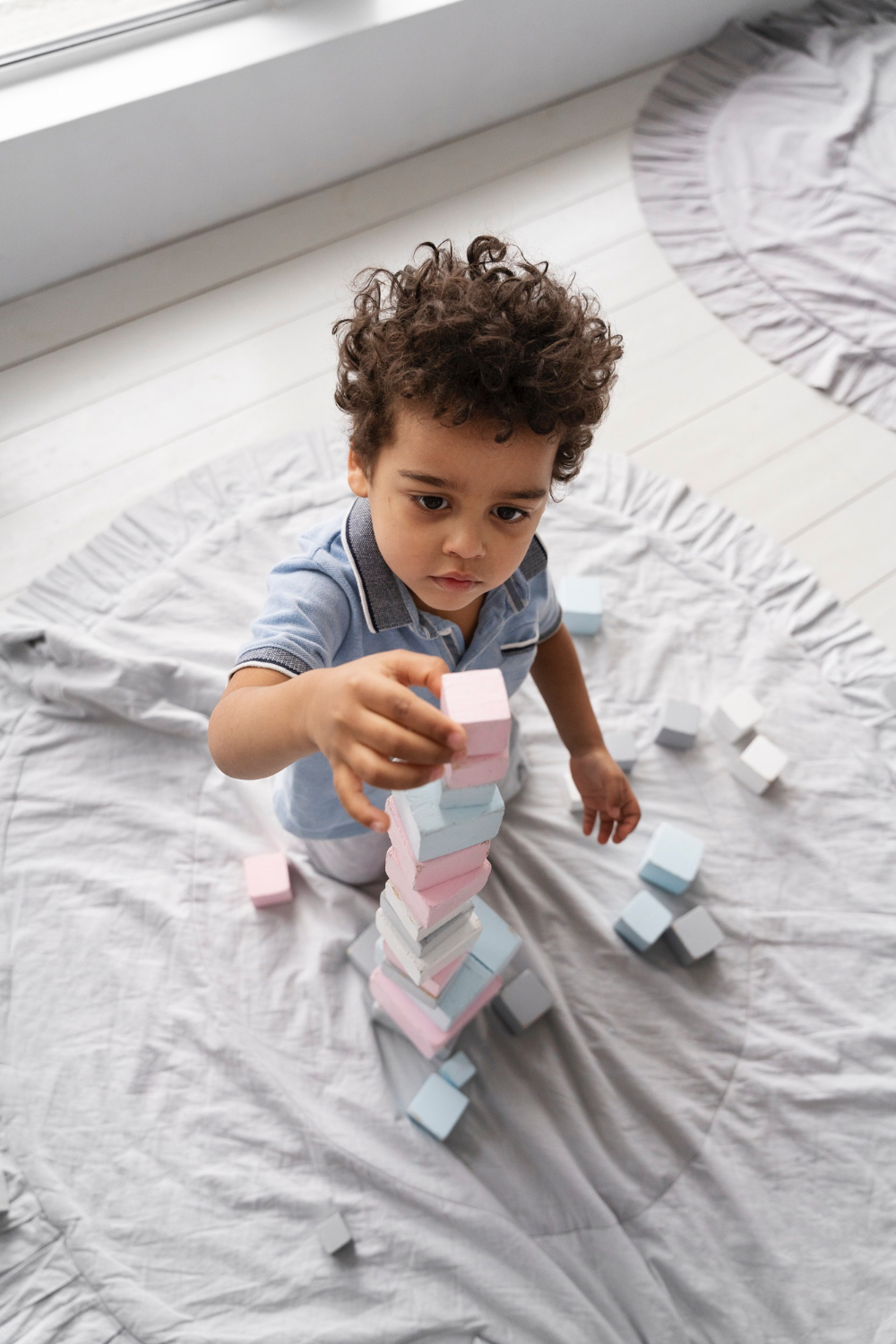 Return to Articles
Return to Articles
8.01.2025
Activity Corner - Brain Boosting with Building Play: Brain Boosting with Building Play

When you picture your child building towers out of blocks or playing inside a cardboard box, it may look like simple play. But to a young child, it’s serious brain work. Activities like stacking, balancing, pretending, and problem-solving help children grow important skills that will support them for years to come. Even better—this kind of play doesn’t require expensive toys or special equipment. You can use everyday items from around your house to create a world of fun, learning, and imagination.
5 Reasons Why Building Play is Powerful
Building play helps young children develop in many ways. Here are just a few examples:
- Thinking and Problem-Solving Skills
When children stack blocks or build a structure, they’re learning about cause and effect. “What happens if I stack too many blocks on top?” or “How can I keep this wall from falling down?” They begin to plan, test ideas, and fix problems when things don’t work.
- Math and Spatial Skills
Children learn math ideas naturally through building—counting, sorting, measuring, and comparing sizes. They also start to understand where things are in space: “next to,” “on top,” “under,” or “beside.”
- Fine and Gross Motor Skills
Whether your child is placing a small block carefully on a tower or carrying a big box across the room, they are strengthening the muscles in their hands, arms, and body. These skills help with writing, dressing, and other everyday activities.
- Language Development
When you talk with your child during building play, you are helping them build vocabulary. You can name shapes, describe actions, and introduce new words like “balance,” “corner,” or “leaning.”
- Social and Emotional Growth
If your child is playing with a sibling or friend, they learn to share, take turns, and work together. Even solo play can help children learn patience and persistence when a tower falls or an idea doesn’t work out.
What You Can Use for Building Play
You don’t need to buy fancy blocks or construction sets to get started. Many great building materials can be found around your home for free or at low cost.
Try These Everyday Items:
- Cardboard boxes (big and small—like cereal boxes, tissue boxes, or shipping boxes)
- Plastic containers with lids
- Toilet paper and paper towel rolls
- Plastic cups
- Egg cartons
- Shoe boxes
- Recyclable items like bottle caps or small cartons
- Pillows and couch cushions for large-scale building
Just be sure to check that all materials are clean, safe, and free from sharp edges or choking hazards.
5 Easy Activities to Try at Home
Here are some simple building activities that you and your young child can enjoy together. These activities are great for children ages 2–6, but you can adjust them for younger or older children.
- Stack and Count Challenge
Materials: Blocks, boxes, or plastic cupsWhat to Do: Challenge your child to build the tallest tower they can. Count the pieces as you go. When it falls, celebrate and try again.What They’re Learning: Counting, cause and effect, patience, and hand-eye coordination
- Build a City
Materials: Cardboard boxes, paper, markers or crayonsWhat to Do: Use boxes of different sizes to build buildings. Add windows and signs with paper and markers. You can even make roads out of tape on the floor.What They’re Learning: Creativity, storytelling, and spatial awareness
- Shape Sorting and Matching
Materials: Different shaped containers or blocksWhat to Do: Help your child sort by shape—circles, squares, rectangles, triangles. Name the shapes and compare them.What They’re Learning: Math and early geometry, sorting, and vocabulary
- Create a Ramp
Materials: Cardboard, small balls or toy carsWhat to Do: Prop up a piece of cardboard like a ramp. Let your child roll different objects down and compare how fast they go.What They’re Learning: Early science, gravity, and observation skills
- Box Tunnel Adventure
Materials: Large boxes, scissors (for adult use), markersWhat to Do: Cut doors and windows in big boxes to create a tunnel or maze. Let your child crawl through, decorate it, or pretend it’s a spaceship or cave.What They’re Learning: Gross motor skills, imagination, and problem-solving
Tips for Parents and Caregivers
- Follow your child’s lead. Let them be the “builder-in-charge.” Ask open-ended questions like, “What are you building?” or “What do you think will happen next?”
- Use rich language. Introduce new words and describe what’s happening. For example: “You stacked the red block on top of the tall blue one.”
- Don’t worry about making it perfect. Mistakes are part of learning. If the tower falls, it’s a chance to try again and build resilience.
- Make clean-up part of the fun. Turn clean-up into a game by sorting blocks by size or color, or racing to see who can put away the most pieces.
Adapting Activities to Your Environment
Whether you live in a small apartment, a mobile home, or a house with a backyard, you can find ways to make building play work for your family.
- In small spaces: Use a corner of the room or a mat to define a “building zone.” Store materials in a bin or basket when not in use.
- Outside play: Take building activities to the backyard or park. Use natural materials like sticks, rocks, and leaves to create sculptures or forts.
- On the go: Pack small items like stacking cups or nesting containers in your bag for playtime at the laundromat, waiting room, or during travel.
Let the Building Begin!
The next time your child is stacking blocks, crawling through a cardboard box, or making a fort out of couch cushions, remember—they’re not just playing. They’re learning how to think, explore, imagine, and grow.
These small moments at home help build a strong foundation for school, relationships, and life. And you don’t need a lot of money or materials—just time, encouragement, and the freedom to explore.
At First 5 Nevada, we believe that parents and caregivers are children’s first and most important teachers. Through activities like building and pretend play, you’re helping your child develop the brain skills they need to succeed.
So grab a box, stack some cups, and watch your little builder’s brain grow!
First 5 Nevada Resources to Support Brain Development
- Vroom! offers resources for families and providers to help turn everyday activities into opportunities to improve brain development.
- Developmental Milestones are skills and behaviors that babies and young children experience at certain stages as they grow. Review the milestones by age, download the Developmental Milestones checklist, or the CDC’s Milestone Tracker App.
- Learn More: Read the First 5 Nevada article “Early Childhood Brain Development” to learn about the 5 Keys to Understanding and Supporting Brain Development or “The Science of Early Childhood Development” from the Harvard Center on the Developing Child.






